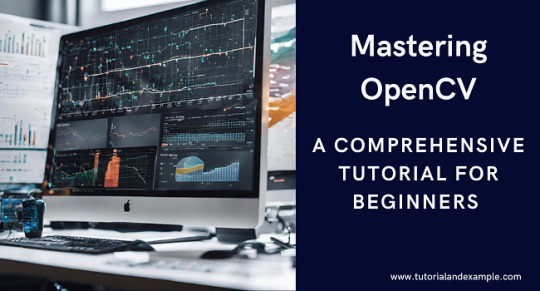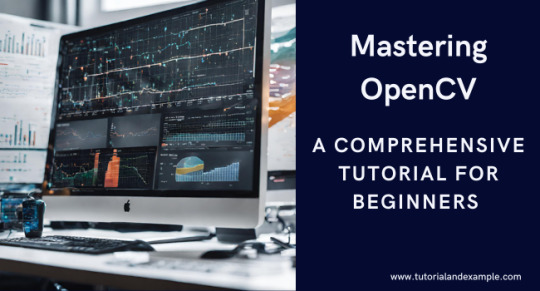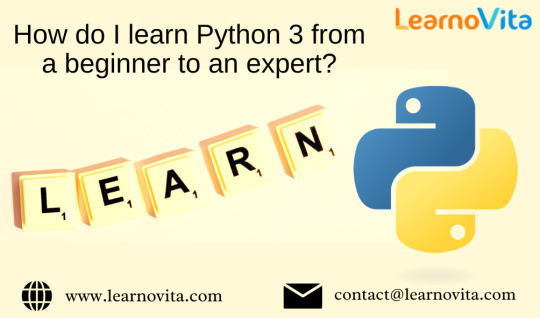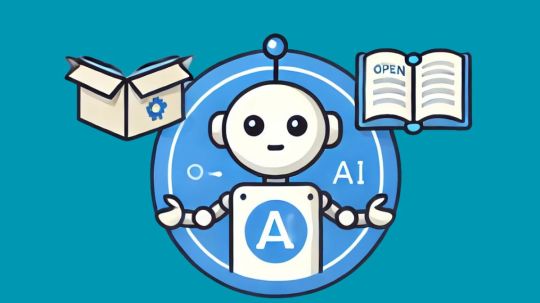#OpenCV Tutorial
Explore tagged Tumblr posts
Text
Mastering OpenCV: A Comprehensive Tutorial for Beginners and Beyond

Are you ready to unlock the fascinating world of computer vision? Dive into this easy-to-follow OpenCV tutorial that will take you from a beginner to a confident explorer of image processing.
Getting Started with OpenCV:
Understanding OpenCV basics is like learning the alphabet of computer vision. Discover how to install OpenCV and set up your development environment. The tutorial provides clear steps, making it a breeze for beginners.
Exploring Image Processing:
Delve into the heart of OpenCV as we unravel the secrets of image processing. Learn essential techniques like image smoothing, edge detection, and color manipulation. With practical examples, you'll grasp the concepts effortlessly.
Mastering Advanced Techniques:
As you progress, the tutorial introduces you to advanced OpenCV techniques. Dive into object detection, feature matching, and facial recognition. You'll be amazed at the possibilities and eager to apply these skills in real-world projects.
Real-World Applications:
Discover how OpenCV transcends theory to become a valuable tool in real-world scenarios. From augmented reality to autonomous vehicles, grasp how professionals use OpenCV to solve complex problems.
Ready to embark on your OpenCV journey? Explore the full tutorial and enhance your skills at Tutorial and Example. It's time to turn your curiosity into expertise!
0 notes
Text
Turn your face into a hilariously cartoonified version of itself using OpenCV and Python. Learn how to cartoonify real-time webcam video using OpenCV and Python. A short yet fun tutorial on edge detection, color filtering, and live video effects.
0 notes
Text
Augmented Realty Bubble Pop Tutorial Bagian 1: Pengaturan Lingkungan Pengembangan
Selamat datang di seri tutorial tentang bagaimana membangun game sederhana menggunakan Python, OpenCV, dan MediaPipe! Dalam tutorial pertama ini, kita akan mempersiapkan lingkungan pengembangan yang diperlukan untuk proyek kita. Tutorial ini sangat penting karena memastikan Anda memiliki semua alat dan pustaka yang diperlukan sebelum kita mulai menulis kode. Mari kita mulai! Langkah 1:…
#Augmented Reality#Augmented Reality Tutorial#game AR bubble pop#instalasi anaconda#membuat environment python#opencv mediapipe pygame#setup python game#tutorial python pemula
0 notes
Text
LEARN ABOUT IMAGE PROCESSING
Image fusion is a process where two or more images are combined to create a single, more informative or visually enhanced image. This technique is used in various fields like photography, remote sensing, medical imaging, and computer vision.

GET PARTICLE IMAGE PROCESSING VIDEO TUTORIAL 🦄
The goal of image fusion is to enhance the overall quality of the final image by combining information from multiple sources while retaining the most relevant details.
Feature-Level Fusion: Instead of combining pixel values, this method focuses on merging the features extracted from images. It's often used in computer vision for object recognition and tracking.
Libraries and Frameworks for Machine Learning Image Processing:
OpenCV-Python is a library of Python bindings designed to solve computer vision problems.
Huge library of image processing algorithms
Open Source + Great Community
Works on both images and videos
Java API Extension
Works with GPUs
Cross-Platform
youtube
#3d printing#ppt image process#image description in alt#image archive#image described#image processing#3d image processing#artificial intelligence#artificial image#techno animation#100 days of productivity#technoland expert#technoland facts#technoart#techno design#Youtube
8 notes
·
View notes
Text
Hmm, thinking about a setup for doing like a poor woman's ar drawing tool using a webcam, Pyodide and OpenCV, it seems like OpenCV should work in Pyodide but there don't seem to be any proper tutorials ☝️ yet
4 notes
·
View notes
Text
🎣 Classify Fish Images Using MobileNetV2 & TensorFlow 🧠
In this hands-on video, I’ll show you how I built a deep learning model that can classify 9 different species of fish using MobileNetV2 and TensorFlow 2.10 — all trained on a real Kaggle dataset! From dataset splitting to live predictions with OpenCV, this tutorial covers the entire image classification pipeline step-by-step.
🚀 What you’ll learn:
How to preprocess & split image datasets
How to use ImageDataGenerator for clean input pipelines
How to customize MobileNetV2 for your own dataset
How to freeze layers, fine-tune, and save your model
How to run predictions with OpenCV overlays!
You can find link for the code in the blog: https://eranfeit.net/how-to-actually-fine-tune-mobilenetv2-classify-9-fish-species/
You can find more tutorials, and join my newsletter here : https://eranfeit.net/
👉 Watch the full tutorial here: https://youtu.be/9FMVlhOGDoo
Enjoy
Eran
#Python #ImageClassification #MobileNetV2
#artificial intelligence#convolutional neural network#deep learning#tensorflow#python#machine learning
0 notes
Text
The Most Important Step in Learning Computer Vision is Writing Your First Line of Code.
Computer Vision is one of the most in-demand skills in the tech industry. But moving from theory to practical application can be intimidating. Where do you even start?
You start with a simple, achievable project.
I've published a step-by-step tutorial specifically for beginners. It's not about complex theory; it's about building momentum and confidence. You will learn how to:
✅ Install and set up the essential OpenCV library in Python. ✅ Write a script to load, display, and manipulate your first image. ✅ Understand the fundamental code blocks used in nearly every CV project.
Investing 15 minutes in this first practical step can be the catalyst for your entire learning journey.
🔗 Build your first project today
0 notes
Link
Adeept RaspTank Smart Robot Car Kit for Raspberry Pi 5/4/3B/3B+(Board Not Included), Tank Tracked Robot with 4-DOF Robotic Arm, OpenCV, Obstacle Avoidance, Line Tracking, USB-C Charging, with Digital Tutorials
0 notes
Text
Build a Custom Object Detection Model with TensorFlow and OpenCV
Okay, so I need to write a comprehensive tutorial about building a custom object detection model using TensorFlow and OpenCV. Let me start by breaking down the structure first. The user has given a clear outline with seven sections, each with specific points to cover. First, the Introduction. I should explain what object detection is and why it’s important. I’ll mention real-world applications…
0 notes
Text

Explore the world of computer vision with our OpenCV tutorial. From fundamental concepts to advanced techniques, master image processing and analysis for real-world applications effortlessly. Dive in now!
0 notes
Text
Mastering Python 3: A Step-by-Step Guide
Python 3 is a powerful, versatile, and beginner-friendly programming language used in various fields, including web development, data science, automation, and artificial intelligence. Whether you are a complete beginner or looking to enhance your skills, following a structured learning approach will help you master Python efficiently.
Considering the kind support of Python Course in Chennai Whatever your level of experience or reason for switching from another programming language, learning Python gets much more fun.

1. Getting Started with Python Basics
Before diving into complex topics, it’s essential to understand the fundamentals of Python. Learn about Python syntax, variables, and data types such as strings, integers, lists, tuples, and dictionaries. Master control structures like if-else statements, loops (for and while), and functions to write reusable and efficient code.
2. Writing and Running Your First Programs
Hands-on practice is key to mastering Python. Start by writing simple programs such as a calculator, a to-do list, or a number guessing game. Use interactive coding platforms like Codecademy, Replit, or Jupyter Notebook to test and debug your code easily.
3. Understanding Object-Oriented Programming (OOP)
Object-Oriented Programming is essential for developing scalable applications. Learn how to create and use classes and objects. Understand key OOP principles like inheritance, encapsulation, polymorphism, and abstraction. Try building a small project using OOP concepts, such as a basic inventory system or a contact management application.
4. Diving into Intermediate Python Concepts
Once you’re comfortable with the basics, explore more advanced topics, including:
File Handling: Reading and writing files in Python.
Error Handling: Using try-except blocks to handle exceptions.
Regular Expressions: Searching and manipulating text data efficiently.
Modules and Packages: Organizing code into reusable components.
5. Working with Databases and APIs
Python is widely used for data management. Learn how to interact with:
SQL Databases like MySQL and SQLite to store structured data.
NoSQL Databases like MongoDB for flexible data storage.
APIs using the requests library to fetch and integrate external data. With the aid of Best Online Training & Placement Programs, which offer comprehensive training and job placement support to anyone looking to develop their talents, it’s easier to learn this tool and advance your career.

6. Choosing a Specialization in Python
Depending on your career goals, Python offers multiple specializations:
Web Development – Learn Django or Flask for backend development.
Data Science & Machine Learning – Work with Pandas, NumPy, Scikit-learn, and TensorFlow.
Automation & Scripting – Use Selenium, PyAutoGUI, and OpenCV.
Cybersecurity & Ethical Hacking – Explore penetration testing tools with Python.
7. Building Real-World Python Projects
Applying Python to real-world projects enhances learning and problem-solving skills. Try building:
A web scraper using BeautifulSoup.
A chatbot with AI integration.
A data visualization dashboard using Matplotlib and Seaborn.
8. Contributing to Open Source and Networking
Join the Python community by contributing to open-source projects on GitHub. Engage in discussions on platforms like Stack Overflow, Reddit, and Discord. Collaborating with others helps you learn best practices and stay updated with the latest trends.
9. Preparing for Python Certifications and Job Interviews
If you aim to use Python professionally, consider earning certifications such as:
Google IT Automation with Python.
Microsoft Certified: Python Associate.
PCEP (Certified Entry-Level Python Programmer).
Prepare for job interviews by solving Python coding challenges on LeetCode, CodeWars, and HackerRank.
10. Staying Updated and Continuous Learning
Python evolves with new libraries and frameworks. Keep learning by following Python blogs, watching tutorials, and working on new projects. Experimenting with trending technologies like AI, blockchain, and cloud computing will keep your Python skills relevant and in demand.
By following this step-by-step guide, practicing regularly, and working on real-world projects, you can progress from a beginner to an expert in Python 3 and unlock a wide range of career opportunities.
0 notes
Text
Membuat Augmented Reality Game Bubble Pop dengan Python
Pernahkah Anda ingin membuat game Augmented Reality (AR) sederhana dengan Python? Dalam serangkaian tutorial ini, Saya akan memandu Anda melalui langkah-langkah untuk menciptakan game Bubble Pop berbasis AR, di mana pemain dapat memecahkan gelembung yang muncul di layar hanya dengan gerakan tangan mereka. Proyek ini tidak hanya menyenangkan tetapi juga merupakan cara yang efektif untuk…
#Augmented Reality game dengan Python#Bubble Pop game Python#OpenCV dan MediaPipe#Python AR game tutorial#tutorial deteksi tangan
0 notes
Text

Learn the basics of computer vision by starting with Python, libraries like OpenCV or TensorFlow, and foundational concepts like image processing. Explore tutorials, online courses, and hands-on projects to build practical skills and understanding.
To know more Visit: www.iabac.org
#iabac#online certification#certification#machine learning#data analytics#professional certification#iabac certification#data science#hr#hr analytics
0 notes
Text
The Power of Python
In the ever-evolving world of technology, programming skills are in high demand, and Python has emerged as one of the most popular languages to learn. Whether you’re a beginner exploring the tech field or a seasoned professional looking to upskill, learning Python offers numerous benefits. Here's why Python is a must-learn language for anyone stepping into the tech ecosystem.
1. Beginner-Friendly Syntax
Python is renowned for its simplicity and readability, making it an ideal choice for beginners. The syntax is straightforward and closely resembles the English language, reducing the learning curve for new programmers. This user-friendly nature allows learners to focus on problem-solving rather than struggling with complex syntax.
2. Versatility Across Industries
Python is a general-purpose programming language used across various industries. From web development to data science, artificial intelligence (AI), machine learning (ML), automation, and even game development, Python’s versatility makes it an invaluable skill in today’s job market.
3. Extensive Libraries and Frameworks
Python’s rich ecosystem of libraries and frameworks simplifies complex tasks. For example:
Pandas and NumPy for data analysis
TensorFlow and PyTorch for machine learning
Flask and Django for web development
Matplotlib and Seaborn for data visualization These tools empower developers to build robust applications efficiently.
4. High Demand in the Job Market
Python is one of the most sought-after skills in the tech industry. Roles like data scientists, machine learning engineers, software developers, and web developers often list Python as a required skill. Learning Python can significantly enhance your employability and open doors to lucrative career opportunities.
5. Supportive Community and Resources
Python boasts a vast and active community of developers worldwide. This community ensures that learners and professionals have access to ample resources, tutorials, forums, and documentation. No matter the challenge, you’re likely to find solutions or guidance from fellow Python enthusiasts.
6. Automation Made Easy
Python simplifies the process of automating repetitive tasks, saving time and increasing productivity. With libraries like Selenium and BeautifulSoup, you can automate tasks such as web scraping, data entry, and testing, enhancing efficiency in personal and professional projects.
7. Platform Independence
Python is a cross-platform language, meaning you can write and run Python code on various operating systems, including Windows, macOS, and Linux. This flexibility ensures that your skills are applicable across diverse environments.
8. Great for Data Science and AI
In the age of big data, Python is a cornerstone language for data science and AI. Its ease of use, coupled with powerful libraries like Scikit-learn, Keras, and OpenCV, makes it the go-to choice for data-driven fields. Python’s capabilities allow professionals to analyze data, build predictive models, and create intelligent systems effectively.
9. Encourages Problem-Solving Skills
Learning Python not only teaches you how to code but also helps you develop critical thinking and problem-solving skills. These skills are transferable across various domains, making Python a valuable tool for both technical and non-technical roles.
10. Future-Proof Your Career
Python’s growth trajectory shows no signs of slowing down. Its widespread adoption in emerging fields like AI, machine learning, and blockchain ensures that Python will remain relevant for years to come. By learning Python, you’re investing in a skill that will keep you ahead in the tech landscape.
Conclusion
Python is more than just a programming language; it’s a gateway to endless possibilities. Whether you aspire to develop cutting-edge applications, analyze data, or automate tasks, Python offers the tools and community to help you succeed. Start your Python journey today and unlock a world of opportunities in technology and beyond.
#datascience#data analytics#python#data analysis#machinelearning#artificial intelligence#youtube#ai#data science course#digital marketing
0 notes
Text
How Open Source AI Works? Its Advantages And Drawbacks

What Is Open-source AI?
Open source AI refers to publicly available AI frameworks, methodologies, and technology. Everyone may view, modify, and share the source code, encouraging innovation and cooperation. Openness has sped AI progress by enabling academics, developers, and companies to build on each other’s work and create powerful AI tools and applications for everyone.
Open Source AI projects include:
Deep learning and neural network frameworks PyTorch and TensorFlow.
Hugging Face Transformers: Language translation and chatbot NLP libraries.
OpenCV: A computer vision toolbox for processing images and videos.
Through openness and community-driven standards, open-source AI increases accessibility to technology while promoting ethical development.
How Open Source AI Works
The way open-source AI operates is by giving anybody unrestricted access to the underlying code of AI tools and frameworks.
Community Contributions
Communities of engineers, academics, and fans create open-source AI projects like TensorFlow or PyTorch. They add functionality, find and solve errors, and contribute code. In order to enhance the program, many people labor individually, while others are from major IT corporations, academic institutions, and research centers.
Access to Source Code
Open Source AI technologies’ source code is made available on websites such as GitHub. All the instructions needed for others to replicate, alter, and comprehend the AI’s operation are included in this code. The code’s usage is governed by open-source licenses (such MIT, Apache, or GPL), which provide rights and restrictions to guarantee equitable and unrestricted distribution.
Building and Customizing AI Models
The code may be downloaded and used “as-is,” or users can alter it to suit their own requirements. Because developers may create bespoke AI models on top of pre-existing frameworks, this flexibility permits experimentation. For example, a researcher may tweak a computer vision model to increase accuracy for medical imaging, or a business could alter an open-source chatbot model to better suit its customer service requirements.
Auditing and Transparency
Because anybody may examine the code for open source AI, possible biases, flaws, and mistakes in AI algorithms can be found and fixed more rapidly. Because it enables peer review and community-driven changes, this openness is particularly crucial for guaranteeing ethical AI activities.
Deployment and Integration
Applications ranging from major business systems to mobile apps may be linked with open-source AI technologies. Many tools are accessible to a broad range of skill levels because they provide documentation and tutorials. Open-source AI frameworks are often supported by cloud services, allowing users to easily expand their models or incorporate them into intricate systems.
Continuous Improvement
Open-source AI technologies allow users to test, improve, update, and fix errors before sharing the findings with the community. Open Source AI democratizes cutting-edge AI technology via cross-sector research and collaboration.
Advantages Of Open-Source AI
Research and Cooperation: Open-source AI promotes international cooperation between organizations, developers, and academics. They lessen effort duplication and speed up AI development by sharing their work.
Transparency and Trust: Open source AI promotes better trust by enabling people to examine and comprehend how algorithms operate. Transparency ensures AI solutions are morally and fairly sound by assisting in the detection of biases or defects.
Startups: Smaller firms, and educational institutions that cannot afford proprietary solutions may employ open-source AI since it is typically free or cheap.
Developers: May customize open-source AI models to meet specific needs, improving flexibility in healthcare and finance. Open Source AI allows students, developers, and data scientists to explore, improve, and participate in projects.
Open-Source AI Security and Privacy issues: Unvetted open source projects may provide security issues. Attackers may take advantage of flaws in popular codebases, particularly if fixes or updates are sluggish.
Quality and Upkeep: Some open-source AI programs have out-of-date models or compatibility problems since they don’t get regular maintenance or upgrades. Projects often depend on unpaid volunteers, which may have an impact on the code’s upkeep and quality.
Complexity: Implementing Open Source AI may be challenging and may call for a high level of experience. Users could have trouble with initial setup or model tweaking in the absence of clear documentation or user assistance.
Ethics and Bias Issues: Training data may introduce biases into even open-source AI, which may have unforeseen repercussions. Users must follow ethical standards and do thorough testing since transparent code does not always translate into equitable results.
Commercial Competition: Open-source initiatives do not have the funds and resources that commercial AI tools possess, which might impede scaling or impede innovation.
Drawbacks
Open source AI is essential to democratizing technology.
Nevertheless, in order to realize its full potential and overcome its drawbacks, it needs constant maintenance, ethical supervision, and active community support.
Read more on Govindhtech.com
#OpensourceAI#Deeplearning#PyTorch#TensorFlow#AImodels#AIprograms#AIdevelopment#AItechnologies#AIframeworks#AItools#News#Technews#Technology#technologynews#Technologytrends#govindhtech
0 notes